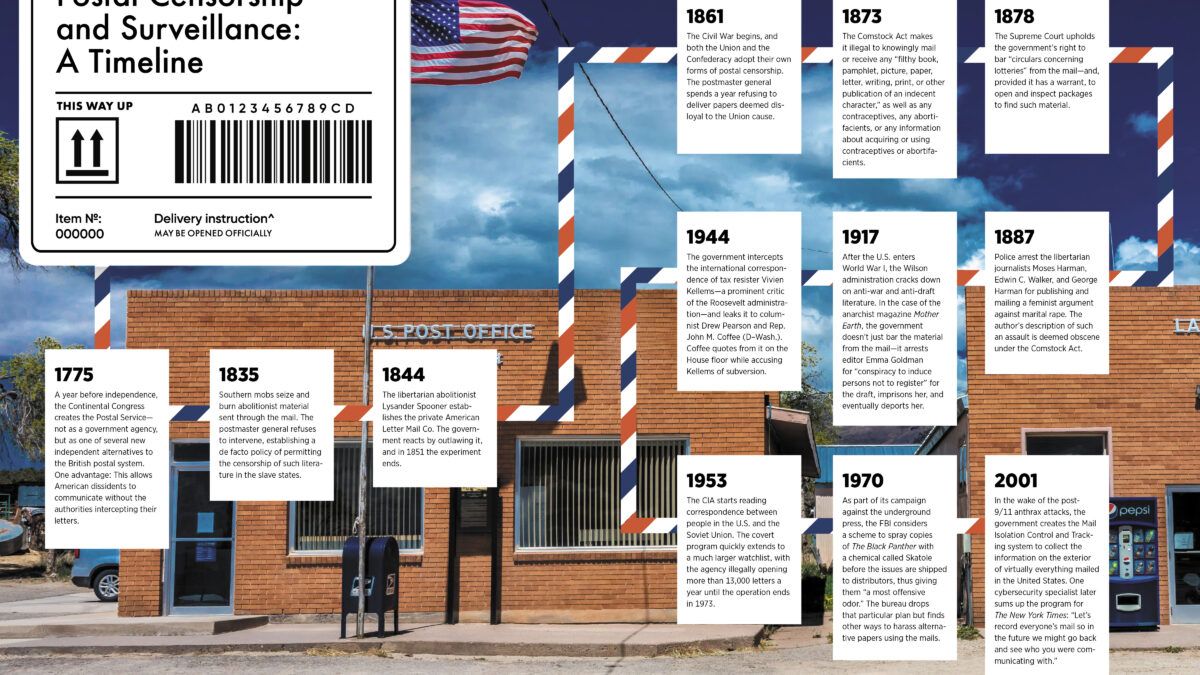Postal Censorship and Surveillance: A Timeline
The government's long and shameful history of intercepting people's letters

1775
A year before independence, the Continental Congress creates the Postal Service—not as a government agency, but as one of several new independent alternatives to the British postal system. One advantage: This allows American dissidents to communicate without the authorities intercepting their letters.
1835
Southern mobs seize and burn abolitionist material sent through the mail. The postmaster general refuses to intervene, establishing a de facto policy of permitting the censorship of such literature in the slave states.
1844
The libertarian abolitionist Lysander Spooner establishes the private American Letter Mail Co. The government reacts by outlawing it, and in 1851 the experiment ends.
1861
The Civil War begins, and both the Union and the Confederacy adopt their own forms of postal censorship. The postmaster general spends a year refusing to deliver papers deemed disloyal to the Union cause.
1873
The Comstock Act makes it illegal to knowingly mail or receive any "filthy book, pamphlet, picture, paper, letter, writing, print, or other publication of an indecent character," as well as any contraceptives, any abortifacients, or any information about acquiring or using contraceptives or abortifacients.
1878
The Supreme Court upholds the government's right to bar "circulars concerning lotteries" from the mail—and, provided it has a warrant, to open and inspect packages to find such material.
1887
Police arrest the libertarian journalists Moses Harman, Edwin C. Walker, and George Harman for publishing and mailing a feminist argument against marital rape. The author's description of such an assault is deemed obscene under the Comstock Act.
1917
After the U.S. enters World War I, the Wilson administration cracks down on anti-war and anti-draft literature. In the case of the anarchist magazine Mother Earth, the government doesn't just bar the material from the mail—it arrests editor Emma Goldman for "conspiracy to induce persons not to register" for the draft, imprisons her, and eventually deports her.
1944
The government intercepts the international correspondence of tax resister Vivien Kellems—a prominent critic of the Roosevelt administration—and leaks it to columnist Drew Pearson and Rep. John M. Coffee (D–Wash.). Coffee quotes from it on the House floor while accusing Kellems of subversion.
1953
The CIA starts reading correspondence between people in the U.S. and the Soviet Union. The covert program quickly extends to a much larger watchlist, with the agency illegally opening more than 13,000 letters a year until the operation ends in 1973.
1970
As part of its campaign against the underground press, the FBI considers a scheme to spray copies of The Black Panther with a chemical called Skatole before the issues are shipped to distributors, thus giving them "a most offensive odor." The bureau drops that particular plan but finds other ways to harass alternative papers using the mails.
2001
In the wake of the post-9/11 anthrax attacks, the government creates the Mail Isolation Control and Tracking system to collect the information on the exterior of virtually everything mailed in the United States. One cybersecurity specialist later sums up the program for The New York Times: "Let's record everyone's mail so in the future we might go back and see who you were communicating with."

Show Comments (21)